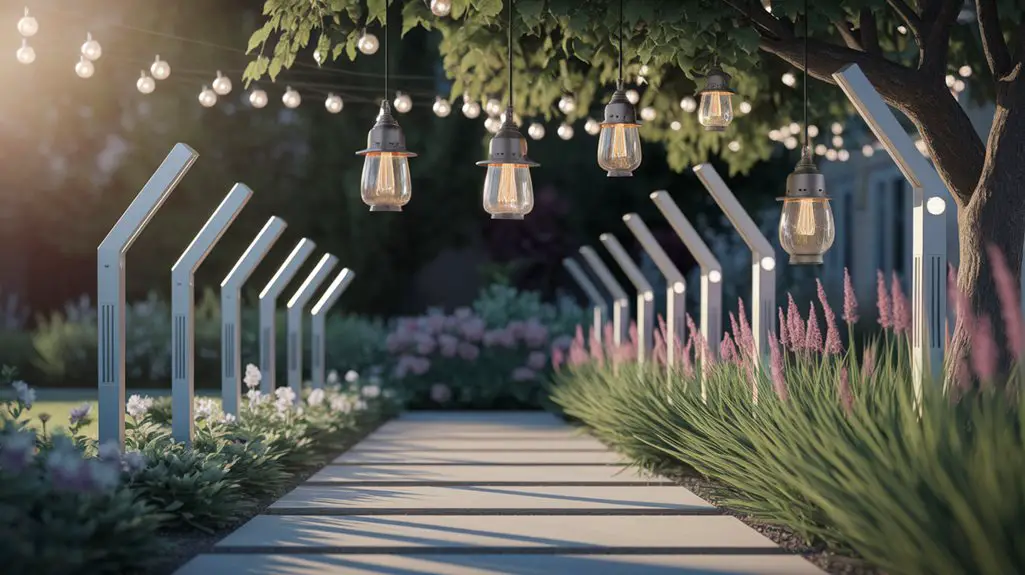You'll find solar garden lighting offers an eco-friendly way to transform your outdoor space after sunset. By harnessing the sun's energy during daylight hours, these fixtures eliminate electricity costs while reducing your carbon footprint. From subtle path markers to dramatic feature illumination, today's solar options combine practical functionality with aesthetic appeal. The right selection depends on your garden's layout, local climate conditions, and your lighting goals—factors we'll explore to help you create the perfect nighttime landscape.
Understanding Solar Technology for Garden Illumination
While traditional garden lighting relies on grid electricity, solar-powered alternatives harness the sun's renewable energy through photovoltaic cells. These cells convert sunlight into electrical energy, storing it in rechargeable batteries for nighttime illumination.
You'll find most solar lights contain four key components: the solar panel, LED bulb, rechargeable battery, and a photoresistor.
Efficiency depends on panel quality, battery capacity, and local sunlight conditions. Premium monocrystalline panels capture more energy even in partial shade than polycrystalline alternatives. Modern solar lights use energy-efficient LEDs that maximize runtime while minimizing battery drain.
For peak performance, position your solar lights where they'll receive 6-8 hours of direct sunlight daily.
Remember that seasonal variations affect charging capacity—winter installations may require supplemental power sources in northern climates.
Types of Solar Lights for Different Garden Areas

Garden spaces benefit from strategic illumination tailored to each area's specific function and aesthetic requirements. You'll find specialized solar fixtures designed for distinct zones, each optimizing light distribution while conserving energy.
- Pathway Lights – Low-profile stakes with downward-facing LEDs prevent light pollution while providing safe navigation through garden corridors.
- Accent Spotlights – Adjustable, focused beams highlight specimen plants, statuary, or architectural elements with precise illumination control.
- Ambient String Lights – Weatherproof LED strands create diffused overhead illumination for dining areas and social spaces with minimal energy consumption.
- Security Flood Lights – Motion-activated, high-lumen fixtures with extended solar panels provide perimeter protection while remaining off-grid.
Select fixtures based on your microclimate's solar exposure, ensuring adequate charging potential for each installation location. Additionally, incorporating stunning lighting designs can enhance the overall atmosphere of your garden space.
Installation and Placement Tips for Maximum Efficiency

Proper placement of solar lighting systems determines whether your fixtures will harness sufficient photovoltaic energy to function effectively throughout the night. Position panels where they'll receive 6-8 hours of direct sunlight daily, typically facing south in northern hemisphere installations, while avoiding shade from structures or vegetation. Additionally, consider the solar-powered lights that can enhance your backyard's aesthetic while providing functionality.
| Placement Area | Ideal Angle | Maintenance Needs |
|---|---|---|
| Pathways | 45° south | Monthly dust removal |
| Entry Points | 30-60° south | Quarterly lens cleaning |
| Garden Borders | Adjustable | Seasonal repositioning |
When installing in-ground fixtures, make sure the stake penetrates firmly into compacted soil to prevent tilting during weather events. For wall-mounted units, position at least 8 feet high to maximize illumination spread while deterring tampering. Clean panels regularly, as even minimal dust accumulation can reduce charging efficiency by up to 25%.
Maintaining and Troubleshooting Your Solar Lighting System
Solar lighting systems require regular maintenance to preserve their functionality and extend operational lifespan.
You'll need to clean solar panels quarterly to remove dirt that obstructs photovoltaic efficiency. Check battery compartments for corrosion and replace rechargeable batteries every 1-2 years for peak performance.
When troubleshooting performance issues, consider these common solutions:
- Reposition panels to maximize direct sunlight exposure (6+ hours daily)
- Clear debris from light sensors that may trigger false dusk-to-dawn activation
- Verify waterproof seals remain intact, replacing damaged gaskets to prevent moisture infiltration
- Reset fixtures by turning them off for 72 hours to fully discharge, then recharge under direct sunlight
During winter months, expect reduced illumination duration due to decreased solar radiation.
Consider seasonal adjustments or supplemental power options for consistent year-round illumination.
Creative Design Ideas for Solar-Lit Outdoor Spaces
Innovative landscaping designs flourish when you thoughtfully integrate solar lighting to create both functional and aesthetic outdoor environments.
Position pathway lights asymmetrically to establish visual rhythm rather than rigid patterns. For visually striking focal points, cluster three to five spotlights with varied intensity levels around specimen trees or sculptures.
Consider vertical illumination by installing string lights on pergolas or fence lines to expand perceived spatial dimensions. Layer your light sources—combine low-profile ground fixtures with hanging lanterns or wall-mounted sconces for depth.
For water features, submerge floating solar orbs that evolve through spectrum shifts as darkness intensifies.
Leverage color strategically: warm white (2700K) enhances organic elements while cool white (4000K) accentuates architectural components.
Remember that negative space—areas deliberately left unlit—creates dramatic contrast that elevates your garden's nighttime identity. Additionally, using solar-powered lighting can significantly reduce energy costs while contributing to a sustainable environment.
Conclusion
You've now illuminated your path to sustainable garden lighting. By selecting the right solar fixtures, calibrating their placement like an astronomer charting celestial bodies, and implementing regular maintenance, you're creating an energy-efficient nightscape. Your garden won't just showcase nature's beauty—it'll harness the sun's power through modern photovoltaic technology. This elegant marriage of aesthetics and renewable energy transforms your outdoor space into an eco-conscious illumination masterpiece.




